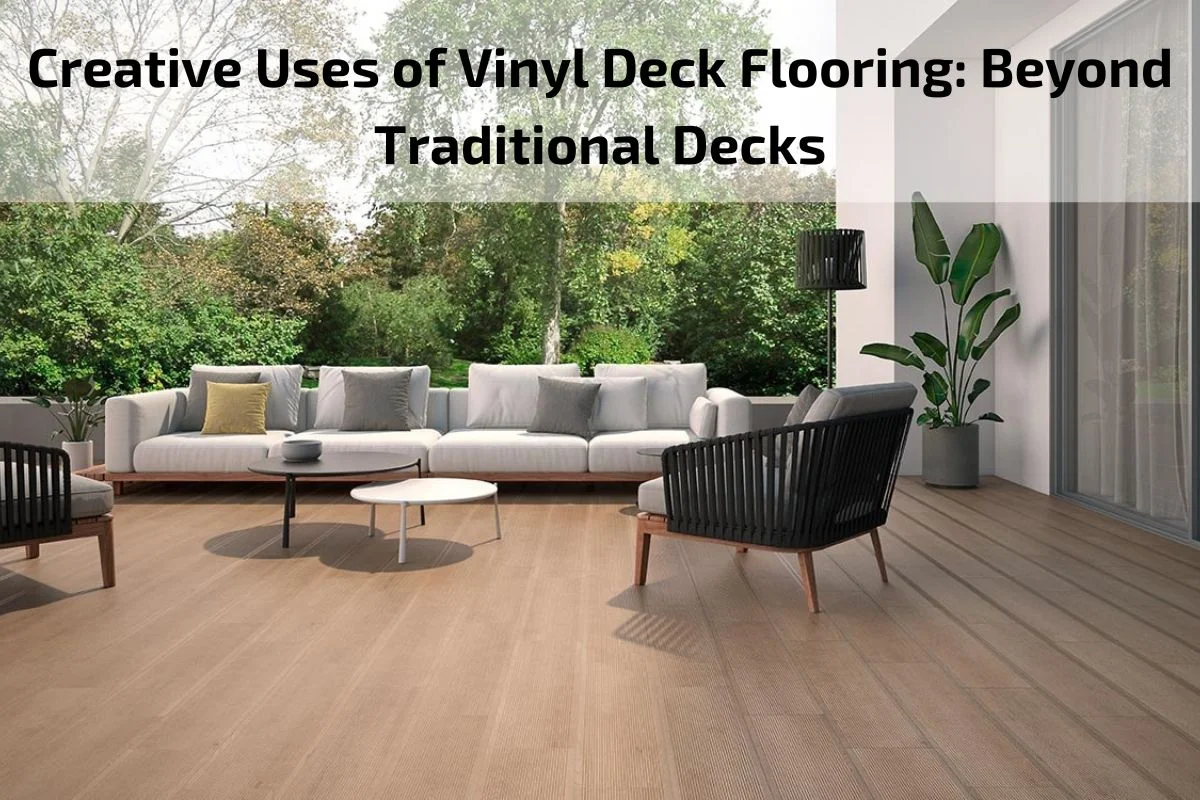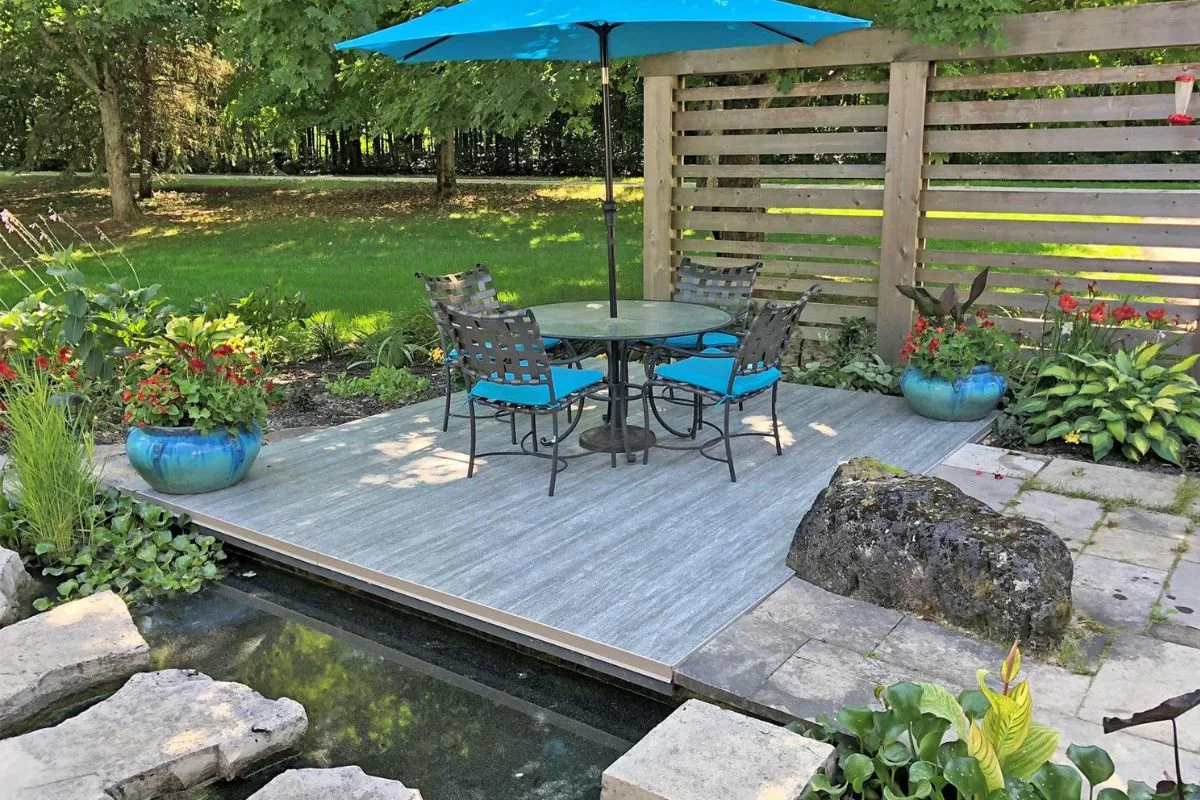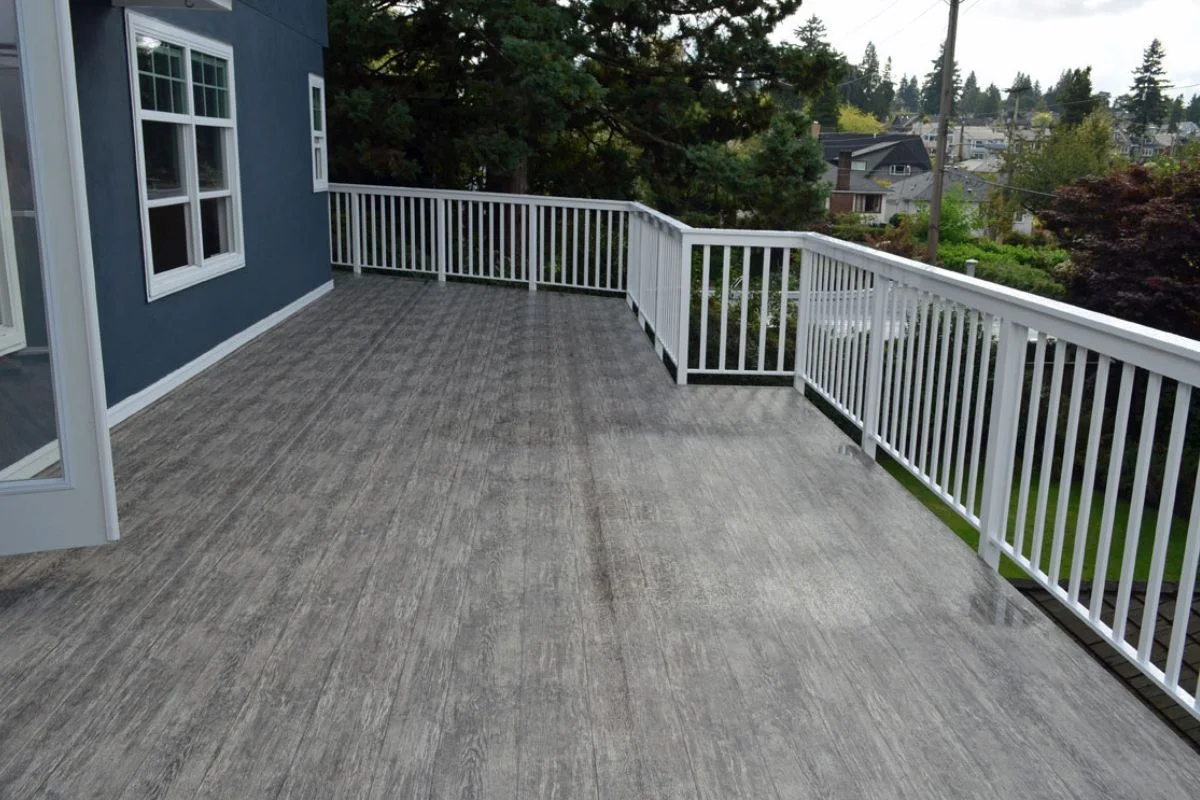
Vinyl deck flooring is a versatile and durable option that offers endless possibilities beyond its traditional use on decks. While it’s commonly associated with outdoor spaces, vinyl flooring can be creatively utilized in various unconventional ways to enhance both indoor and outdoor areas. From adding personality to functional enhancements, vinyl deck flooring presents exciting opportunities for homeowners and designers alike.
In this article, we’ll explore creative uses of vinyl deck flooring beyond traditional decks, showcasing innovative ideas to inspire your next home improvement project. Whether you’re looking to revamp your patio, upgrade your balcony, or create unique outdoor features, vinyl flooring can be a game-changer in transforming spaces with style and practicality.
Brief overview of vinyl deck flooring
Vinyl deck flooring is a versatile and durable outdoor flooring option that offers numerous advantages for homeowners. Made from synthetic materials, vinyl deck flooring is designed to withstand outdoor elements such as moisture, UV exposure, and temperature fluctuations, making it ideal for use in outdoor spaces like decks, patios, balconies, and porches. Available in a variety of styles, colors, and textures, vinyl deck flooring can mimic the look of natural materials like wood or stone while offering the added benefits of easy maintenance, resistance to mold and mildew, and long-lasting performance. Its affordability, versatility, and low maintenance requirements make vinyl deck flooring a popular choice for homeowners looking to enhance the aesthetics and functionality of their outdoor living areas.
Importance of exploring creative uses beyond vinyl deck flooring
Exploring creative uses beyond traditional applications of vinyl deck flooring is crucial for several reasons:
Versatility: Vinyl deck flooring is not limited to just outdoor decks. Exploring creative uses allows homeowners to discover its versatility and adaptability for various indoor and outdoor spaces, including patios, balconies, porches, and even interior rooms.
Aesthetic Enhancement: By thinking outside the box, homeowners can use vinyl deck flooring to enhance the aesthetic appeal of their living spaces. Creative applications can add visual interest, texture, and personality to both indoor and outdoor areas, elevating the overall design of the home.
Functional Innovation: Thinking creatively about vinyl deck flooring opens up opportunities for functional innovation. Whether it’s creating custom furniture pieces, accent walls, or unique seating areas, exploring alternative uses allows homeowners to maximize the functionality and usability of their spaces.
Customization: Creative uses of vinyl deck flooring enable homeowners to personalize their living environments according to their tastes and preferences. By thinking creatively, homeowners can customize their spaces with unique patterns, colors, and designs, resulting in a truly one-of-a-kind look.
Resourcefulness: Exploring creative uses of vinyl deck flooring encourages resourcefulness and sustainability. By repurposing materials in unexpected ways, homeowners can minimize waste, reduce environmental impact, and make the most of their resources.
Exploring the Advantages and Disadvantages of Vinyl Deck Flooring
When considering vinyl deck flooring, it’s important to weigh both its advantages and disadvantages to make an informed decision. Let’s explore:
Advantages:
Durability: Vinyl deck flooring is highly durable and resistant to wear, fading, and staining, making it suitable for outdoor use in various weather conditions.
Low Maintenance: Unlike wood decking, vinyl requires minimal maintenance. Regular cleaning with soap and water is typically all that’s needed to keep it looking its best.
Variety of Styles: Vinyl deck flooring comes in a wide range of colors, patterns, and textures, allowing homeowners to achieve their desired aesthetic without sacrificing durability.
Comfortable Underfoot: Vinyl deck flooring is softer and more comfortable underfoot compared to wood or stone, making it a more pleasant surface to walk on barefoot.
Moisture Resistance: Vinyl is inherently resistant to moisture, making it an ideal choice for areas prone to water exposure, such as pool decks or outdoor patios.
Disadvantages:
Limited Lifespan: While durable, vinyl deck flooring may have a shorter lifespan compared to some other materials like wood or composite decking.
Susceptible to Scratching: While resistant to most types of damage, vinyl deck flooring can still be scratched or gouged by sharp objects or heavy furniture.
Not Environmentally Friendly: Vinyl is a synthetic material made from petroleum-based products, which may not be considered environmentally friendly compared to natural materials like wood.
Limited Repair Options: Unlike wood decking, which can be sanded and refinished, vinyl deck flooring typically cannot be repaired if damaged. In most cases, damaged sections will need to be replaced entirely.
Heat Retention: In hot climates, vinyl deck flooring may retain heat and become uncomfortable to walk on barefoot during the summer months.
Types of Vinyl Deck Flooring: Choosing the Right Option
When selecting vinyl deck flooring, homeowners have several types to choose from, each offering unique features and benefits. Here are the main types of vinyl deck flooring and considerations for choosing the right option:
Vinyl Plank Flooring:
- Description: Vinyl plank flooring mimics the look and texture of hardwood planks, offering a realistic wood appearance with the durability and water resistance of vinyl.
- Benefits: Resistant to moisture, scratches, and stains. Easy to install with a click-lock or adhesive backing. Available in a variety of wood species, colors, and finishes.
- Considerations: Thickness of planks may vary, impacting durability and stability. Some designs may have a repeating pattern that can look less authentic.
Vinyl Tile Flooring:
- Description: Vinyl tile flooring replicates the look of ceramic or stone tiles, offering a durable and cost-effective alternative with easy installation.
- Benefits: Resistant to water, stains, and scratches. Easy to clean and maintain. Available in various sizes, shapes, colors, and patterns to suit different design preferences.
- Considerations: Tile seams may be visible, especially with lighter-colored tiles. Grout lines may require periodic cleaning and maintenance.
Sheet Vinyl Flooring:
- Description: Sheet vinyl flooring comes in large rolls and offers a seamless and waterproof surface for outdoor decks.
- Benefits: Provides a smooth and continuous surface that resists moisture, stains, and scratches. Available in a wide range of styles, including wood and stone looks.
- Considerations: Professional installation is recommended for achieving a seamless finish. Limited design options compared to vinyl planks or tiles.
PVC Decking:
- Description: PVC decking is a type of vinyl decking specifically designed for outdoor use, offering enhanced durability and resistance to the elements.
- Benefits: Highly durable and low maintenance. Resistant to moisture, mold, and mildew. Available in various colors, textures, and finishes.
- Considerations: Can be more expensive than other types of vinyl deck flooring. Installation may require specialized tools and techniques.
Creative Uses of Vinyl Deck Flooring
Creative uses of vinyl deck flooring go beyond traditional applications, offering homeowners innovative ways to enhance both indoor and outdoor spaces. Here are some creative ideas:
Accent Walls: Install vinyl deck flooring vertically on accent walls to add texture, visual interest, and warmth to interior spaces. Choose from a variety of colors, patterns, and textures to complement the existing decor and create a focal point in the room.
Ceiling Coverings: Extend the beauty of vinyl deck flooring overhead by using it to cover ceilings in covered outdoor areas, such as porches or verandas. The durable and weather-resistant nature of vinyl makes it an ideal choice for protecting and enhancing outdoor living spaces.
Custom Furniture: Repurpose vinyl deck flooring to create custom furniture pieces such as outdoor tables, benches, or planters. Cut vinyl planks or tiles to size and use them as durable and weather-resistant surfaces for outdoor furniture projects.
Decorative Borders: Use vinyl deck flooring as decorative borders or accents to delineate different areas of an outdoor space. Create borders around flower beds, garden paths, or seating areas to define the space and add visual appeal.
Outdoor Rugs: Cut vinyl deck flooring into custom shapes and sizes to create outdoor rugs for patios, decks, or balconies. Vinyl rugs provide a comfortable and durable surface underfoot while adding style and personality to outdoor living areas.
DIY Wall Art: Get creative with vinyl deck flooring by cutting it into shapes or patterns to create unique DIY wall art for indoor or outdoor spaces. Arrange vinyl tiles or planks in geometric designs, abstract patterns, or mosaic motifs to add visual interest to walls.
Under-Deck Storage: Utilize the space underneath a raised deck by installing vinyl deck flooring as a durable and waterproof surface for under-deck storage areas. This creative use of vinyl flooring helps maximize outdoor storage space while protecting belongings from moisture and weather damage.
Pet-Friendly Surfaces: Create pet-friendly surfaces by installing vinyl deck flooring in outdoor pet areas, such as dog runs or pet play areas. Vinyl flooring provides a durable, easy-to-clean surface that is resistant to scratches, stains, and pet messes.
DIY Backsplash: Use vinyl deck flooring as a budget-friendly and water-resistant backsplash material in outdoor kitchens, grilling stations, or bar areas. Vinyl tiles or planks can be easily installed on walls to create a stylish and functional backsplash that complements outdoor living spaces.
Temporary Flooring: Use vinyl deck flooring as a temporary flooring solution for outdoor events, parties, or gatherings. Vinyl tiles or rolls can be quickly installed and removed as needed, providing a versatile and portable flooring option for temporary outdoor spaces.
Maintaining Vinyl Deck Flooring: Tips for Long-Term Durability
Maintaining vinyl deck flooring is essential for ensuring its long-term durability and beauty. Here are some tips to help homeowners keep their vinyl deck flooring in top condition:
Regular Cleaning: Sweep or vacuum the vinyl deck flooring regularly to remove dirt, debris, and leaves. Use a mop or soft-bristled brush with a mild detergent solution to clean the surface periodically, especially in high-traffic areas or areas prone to spills.
Avoid Harsh Chemicals: Avoid using abrasive cleaners, harsh chemicals, or abrasive cleaning tools such as steel wool or scouring pads, as they can damage the vinyl surface and cause discoloration or scratches.
Prompt Spill Cleanup: Clean up spills and stains promptly to prevent them from setting into the vinyl surface. Use a soft cloth or sponge with mild detergent and warm water to gently wipe away spills and stains. Avoid using bleach or ammonia-based cleaners, as they can damage the vinyl.
Protective Measures: Place mats or rugs at entryways and high-traffic areas to trap dirt, moisture, and debris before they reach the vinyl deck flooring. Use furniture pads or coasters under heavy furniture to prevent scratches and indentations on the vinyl surface.
Avoid Standing Water: Prevent standing water from accumulating on the vinyl deck flooring, as prolonged exposure to moisture can cause damage and mold growth. Ensure proper drainage and ventilation in outdoor areas to prevent water buildup.
Regular Inspection: Periodically inspect the vinyl deck flooring for signs of wear, damage, or deterioration, such as scratches, gouges, or peeling edges. Address any issues promptly to prevent further damage and maintain the integrity of the vinyl surface.
UV Protection: Protect the vinyl deck flooring from prolonged exposure to direct sunlight, as UV rays can cause fading and discoloration over time. Consider installing awnings, umbrellas, or shades to provide shade and reduce sun exposure to outdoor vinyl surfaces.
Seasonal Maintenance: Perform seasonal maintenance tasks to keep the vinyl deck flooring in top condition. In colder climates, ensure that snow and ice are promptly removed from the surface to prevent damage. In warmer climates, inspect the surface for signs of heat-related damage and take precautions to protect the vinyl from excessive heat.
Avoid Sharp Objects: Prevent scratches and gouges on the vinyl deck flooring by avoiding dragging heavy or sharp objects across the surface. Use furniture pads or protective mats under furniture legs to prevent damage when moving furniture.
Follow Manufacturer’s Recommendations: Follow the manufacturer’s recommendations for cleaning and maintenance to ensure the longevity of the vinyl deck flooring. Refer to the manufacturer’s care instructions for specific guidelines on cleaning products, techniques, and maintenance schedules.
Conclusion
In conclusion, maintaining vinyl deck flooring is crucial for ensuring its long-term durability, functionality, and aesthetic appeal in outdoor spaces. By following the tips outlined in this article, homeowners can keep their vinyl deck flooring in top condition and enjoy its many benefits for years to come.




